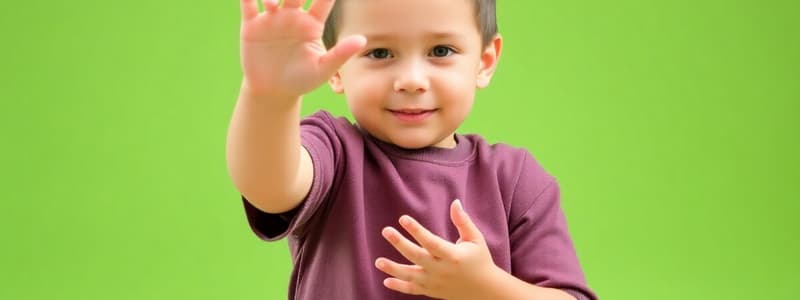Podcast
Questions and Answers
How does Schmidt's Schema Theory explain motor skill adaptation?
How does Schmidt's Schema Theory explain motor skill adaptation?
- Movements are learned through strict adherence to pre-programmed motor sequences.
- Movements are controlled by generalized motor programs, allowing adaptation across different situations. (correct)
- Movements are developed solely through natural exploration without structured instruction.
- Movements are controlled by sensory feedback loops, correcting errors in real-time.
Which of the following best describes the focus of John Rousseau's behavioral theory regarding motor development?
Which of the following best describes the focus of John Rousseau's behavioral theory regarding motor development?
- Emphasizing structured instruction and guided practice for optimal motor learning.
- Reinforcing specific motor behaviors through rewards and consequences.
- Learning motor skills through observation and imitation of others.
- Emphasizing natural movement exploration and free interaction with the environment. (correct)
A child is learning to ride a bicycle. According to Fitts and Posner's three-stage model, which progression would you expect to see?
A child is learning to ride a bicycle. According to Fitts and Posner's three-stage model, which progression would you expect to see?
- Cognitive -> Autonomous -> Associative
- Autonomous -> Associative -> Cognitive
- Cognitive -> Associative -> Autonomous (correct)
- Associative -> Cognitive -> Autonomous
According to Kelso's Dynamic Systems Theory, how does a child learn to walk?
According to Kelso's Dynamic Systems Theory, how does a child learn to walk?
Which of the following scenarios exemplifies tactile discrimination?
Which of the following scenarios exemplifies tactile discrimination?
How can a coach best apply the principles of observational learning (Bandura) to teach a complex gymnastics routine?
How can a coach best apply the principles of observational learning (Bandura) to teach a complex gymnastics routine?
A physical therapist is working with a patient who has difficulty with motor planning. Which of the following activities would be MOST appropriate to improve this skill?
A physical therapist is working with a patient who has difficulty with motor planning. Which of the following activities would be MOST appropriate to improve this skill?
Which of the following everyday activities relies most heavily on kinesthetic discrimination?
Which of the following everyday activities relies most heavily on kinesthetic discrimination?
A child struggles to catch a ball due to mistiming their hand movements with the ball's trajectory. Which type of awareness is the child primarily lacking?
A child struggles to catch a ball due to mistiming their hand movements with the ball's trajectory. Which type of awareness is the child primarily lacking?
A toddler consistently uses a palmer grasp to pick up objects, even when smaller objects are presented. Based on typical motor development milestones, what is the most likely explanation for this?
A toddler consistently uses a palmer grasp to pick up objects, even when smaller objects are presented. Based on typical motor development milestones, what is the most likely explanation for this?
Which of the following scenarios best illustrates the application of Skinner's operant conditioning in motor skill development?
Which of the following scenarios best illustrates the application of Skinner's operant conditioning in motor skill development?
Why is motor control considered essential in the performance of any motor skill?
Why is motor control considered essential in the performance of any motor skill?
A soccer coach designs a drill where players practice passing the ball to different teammates while running at varying speeds and under pressure from defenders. Which theory is best exemplified by this drill?
A soccer coach designs a drill where players practice passing the ball to different teammates while running at varying speeds and under pressure from defenders. Which theory is best exemplified by this drill?
Which scenario most clearly distinguishes between a locomotor skill and a non-locomotor skill?
Which scenario most clearly distinguishes between a locomotor skill and a non-locomotor skill?
A music teacher is helping a student learn to play the piano. Which of the following instructional strategies would best leverage auditory discrimination skills?
A music teacher is helping a student learn to play the piano. Which of the following instructional strategies would best leverage auditory discrimination skills?
How does Newell's Ecological Theory contrast with traditional motor learning theories?
How does Newell's Ecological Theory contrast with traditional motor learning theories?
Considering the four key aspects of motor task analysis; task complexity, movement type, environmental influence, stages of learning, what would be the most important consideration when teaching someone to ride a bicycle in a busy city?
Considering the four key aspects of motor task analysis; task complexity, movement type, environmental influence, stages of learning, what would be the most important consideration when teaching someone to ride a bicycle in a busy city?
Why is the development of fundamental movement skills considered crucial for overall physical development?
Why is the development of fundamental movement skills considered crucial for overall physical development?
How would Dewey and McGraw's perspective on kinetic energy influence rehabilitation strategies for stroke patients with impaired movement?
How would Dewey and McGraw's perspective on kinetic energy influence rehabilitation strategies for stroke patients with impaired movement?
What differentiates perceptual-motor skills from other types of motor skills?
What differentiates perceptual-motor skills from other types of motor skills?
A person learning how to play baseball is having trouble hitting the ball, and are adjusting their stance based on how they missed the ball the previous attempt at hitting? What closed loop theory are they employing?
A person learning how to play baseball is having trouble hitting the ball, and are adjusting their stance based on how they missed the ball the previous attempt at hitting? What closed loop theory are they employing?
What is the distinction between fine motor skills and gross motor skills during development?
What is the distinction between fine motor skills and gross motor skills during development?
A basketball player is dribbling down the court whilst weaving in and out of other players. Which of the following skill set are they most heavily employing?
A basketball player is dribbling down the court whilst weaving in and out of other players. Which of the following skill set are they most heavily employing?
A child is blindfolded and asked to identify various objects (ball, box, doll) by touching them. This activity primarily assesses the child's:
A child is blindfolded and asked to identify various objects (ball, box, doll) by touching them. This activity primarily assesses the child's:
An occupational therapist is working with a child who has difficulty coordinating movements to button a shirt. Which type of motor skills is the therapist targeting?
An occupational therapist is working with a child who has difficulty coordinating movements to button a shirt. Which type of motor skills is the therapist targeting?
According to Piaget's cognitive theory, how is motor development interconnected with overall cognitive development?
According to Piaget's cognitive theory, how is motor development interconnected with overall cognitive development?
In classical conditioning (Pavlov), what role does the stimulus play in motor skill acquisition?
In classical conditioning (Pavlov), what role does the stimulus play in motor skill acquisition?
A child is unable to distinguish between different sounds. How would you describe this motor learning disability?
A child is unable to distinguish between different sounds. How would you describe this motor learning disability?
An athlete is not aware of their body position and movement, and muscle exertion without visual input. Which type of discrimination is this athlete lacking?
An athlete is not aware of their body position and movement, and muscle exertion without visual input. Which type of discrimination is this athlete lacking?
An archer is lining up an arrow to shoot on a range. How would you describe the archers body awareness?
An archer is lining up an arrow to shoot on a range. How would you describe the archers body awareness?
What is defined as the regulation of movement processes?
What is defined as the regulation of movement processes?
A child is dribbling, kicking and controlling objects. Which skill are they employing?
A child is dribbling, kicking and controlling objects. Which skill are they employing?
How can a child with a basic movement set of running, jumping, throwing, and catching improve?
How can a child with a basic movement set of running, jumping, throwing, and catching improve?
A child is writing, butting a shirt and also participating in team sports. Which skill are they employing?
A child is writing, butting a shirt and also participating in team sports. Which skill are they employing?
What can be said of someone using their four senses and motor skills to interact with the world around them?
What can be said of someone using their four senses and motor skills to interact with the world around them?
Which of the choices is an example of someone using Visual Discrimination
Which of the choices is an example of someone using Visual Discrimination
How does the associative stage of Fitts and Posner's model differ from the cognitive stage in motor skill acquisition?
How does the associative stage of Fitts and Posner's model differ from the cognitive stage in motor skill acquisition?
How does Newell's Ecological Theory redefine the traditional understanding of motor skill acquisition?
How does Newell's Ecological Theory redefine the traditional understanding of motor skill acquisition?
What key distinction sets Schmidt's Schema Theory apart from Adam's Closed-Loop Theory in explaining motor learning?
What key distinction sets Schmidt's Schema Theory apart from Adam's Closed-Loop Theory in explaining motor learning?
According to Kelso's Dynamic Systems Theory, how does the concept of self-organization contribute to motor skill development?
According to Kelso's Dynamic Systems Theory, how does the concept of self-organization contribute to motor skill development?
How do Dewey and McGraw's views on kinetic energy challenge traditional approaches to motor skill development?
How do Dewey and McGraw's views on kinetic energy challenge traditional approaches to motor skill development?
Flashcards
Perceptual motor skills
Perceptual motor skills
Combining senses and motor skills to interact with the world.
Visual Discrimination
Visual Discrimination
Interpreting and responding to stimuli like depth, tracking, shapes.
Auditory Discrimination
Auditory Discrimination
Differentiating sounds, recognizing patterns, and responding.
Tactile Discrimination
Tactile Discrimination
Signup and view all the flashcards
Kinesthetic Discrimination
Kinesthetic Discrimination
Signup and view all the flashcards
Palmer Grasp
Palmer Grasp
Signup and view all the flashcards
Pincer Grasp
Pincer Grasp
Signup and view all the flashcards
Gross Motor Skills
Gross Motor Skills
Signup and view all the flashcards
Fine Motor Skills
Fine Motor Skills
Signup and view all the flashcards
Fundamental Movement Skills
Fundamental Movement Skills
Signup and view all the flashcards
Motor Planning
Motor Planning
Signup and view all the flashcards
Locomotor Skills
Locomotor Skills
Signup and view all the flashcards
Non-locomotor Skills
Non-locomotor Skills
Signup and view all the flashcards
Manipulative Skills
Manipulative Skills
Signup and view all the flashcards
Body Awareness
Body Awareness
Signup and view all the flashcards
Spatial Awareness
Spatial Awareness
Signup and view all the flashcards
Temporal Awareness
Temporal Awareness
Signup and view all the flashcards
Motor Control
Motor Control
Signup and view all the flashcards
Adam's closed loop theory
Adam's closed loop theory
Signup and view all the flashcards
Schmidt's Schema Theory
Schmidt's Schema Theory
Signup and view all the flashcards
Fitts and Posner's model
Fitts and Posner's model
Signup and view all the flashcards
Cognitive Stage
Cognitive Stage
Signup and view all the flashcards
Associative Stage
Associative Stage
Signup and view all the flashcards
Autonomous Stage
Autonomous Stage
Signup and view all the flashcards
John Rousseau theory
John Rousseau theory
Signup and view all the flashcards
Newell Ecological theory
Newell Ecological theory
Signup and view all the flashcards
Kelso Dynamic Systems theory
Kelso Dynamic Systems theory
Signup and view all the flashcards
Dewey and McGraw
Dewey and McGraw
Signup and view all the flashcards
Piaget cognitive theory
Piaget cognitive theory
Signup and view all the flashcards
Pavlov Classical Conditioning
Pavlov Classical Conditioning
Signup and view all the flashcards
Skinner Operant Conditioning
Skinner Operant Conditioning
Signup and view all the flashcards
Bandura Observational Learning
Bandura Observational Learning
Signup and view all the flashcards
Key aspects of motor task analysis
Key aspects of motor task analysis
Signup and view all the flashcards
Study Notes
- Motor development and learning involves various skills and theories related to movement and cognitive understanding.
Perceptual and Discrimination Skills
- Perceptual motor skills combine senses and motor abilities to interact with the world.
- Visual discrimination is the ability to interpret and respond to visual stimuli like depth perception.
- Auditory discrimination is the ability to differentiate sounds and recognize patterns.
- Tactile discrimination involves interpreting and responding to touch stimuli like texture.
- Kinesthetic discrimination, or body awareness, is sensing body position and movement without visual input.
Grasping and Motor Skills
- Palmer grasp is reflexive and lasts until about 6 months old.
- Pincer grasp involves voluntary fine motor pinching movements.
- Gross motor skills involve large muscle groups and develop early in infancy.
- Fine motor skills involve small muscles, like writing, and develop around 6-10 years.
- Fundamental movement skills include basic actions like running, jumping, throwing, and catching.
Planning, Awareness, and Control
- Motor planning is the ability to execute motor tasks requiring multiple skills.
- Locomotor skills transport the body, such as walking and skipping.
- Non-locomotor skills are movements without traveling, like twisting and bending.
- Manipulative skills involve controlling objects, such as dribbling and kicking, and develop around 10+ years.
- Body awareness is the sense of one's own body and its capabilities.
- Spatial awareness is being aware of surroundings and one's position in them.
- Temporal awareness is awareness of movement and time.
- Motor control regulates movement processes.
Theories of Motor Learning
- Adam's closed loop theory suggests movements are learned through feedback loops, correcting errors in real time.
- Schmidt's schema theory proposes movements are controlled by generalized motor programs allowing adaptation across situations.
- Fitts and Posner's three-stage model includes cognitive, associative, and autonomous stages of skill acquisition.
- The cognitive stage involves slow and deliberate movements.
- The associative stage is when movements become smoother.
- The autonomous stage is the final stage where movements are automatic.
- John Rousseau's behavioral theory emphasizes natural movement exploration over structured instruction.
- Newell's ecological theory says that learning occurs through exploration and adaptation to environmental constraints.
- Kelso's dynamic systems theory suggests motor learning emerges from interactions between learner, task, and environment.
- Dewey and McGraw viewed kinetic energy (movement) as a fundamental force in motor development.
- Piaget's cognitive theory ties motor development to the development of cognitive understanding/development.
Conditioning and Learning
- Pavlov's classical conditioning involves associating a stimulus with a movement response.
- Skinner's operant conditioning reinforces desired motor behaviors through rewards or consequences.
- Bandura's observational learning involves learning motor skills by imitating others.
Aspects of Motor Task Analysis
- Motor task analysis includes task complexity, movement type (gross/fine), environmental influence (variable or predictable skills), and the three stages of learning.
Studying That Suits You
Use AI to generate personalized quizzes and flashcards to suit your learning preferences.



